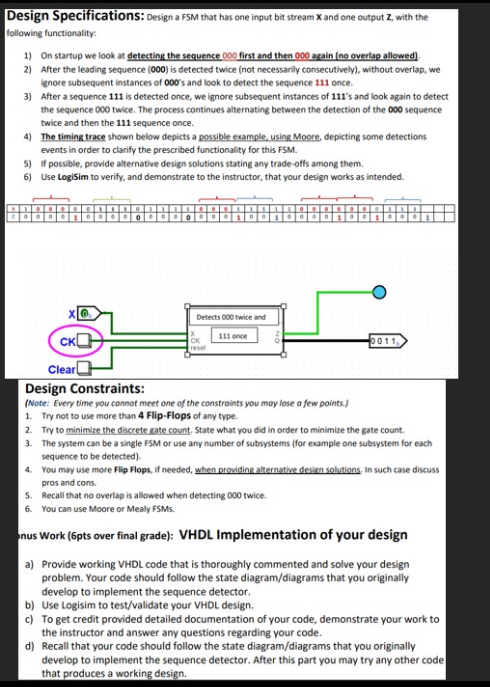Answered step by step
Verified Expert Solution
Question
1 Approved Answer
Design Specifications: Design a FSM that has one input bit stream x and one output z , with the following functionality: On startup we look
Design Specifications: Design a FSM that has one input bit stream and one output with the following functionality:
On startup we look at detecting the sequence first and then again no overlap allowed
After the leading sequence is detected twice not necessarily consecutively without overlap, we ignore subsequent instances of s and look to detect the sequence once.
After a sequence is detected once, we ignore subsequent instances of s and look again to detect the sequence twice. The process continues alternating between the detection of the sequence twice and then the sequence once.
The timing trace shown below depicts a possible example, using Moore depicting some detections events in order to clarify the prescribed functionality for this FSM
If possible, provide alternative design solutions stating any tradeoffs among them.
Use LogiSim to verify, and demonstrate to the instructor, that your design works as intended.
Design Constraints:
Note: Every time you connot meet one of the constraints you may lose a few points.
Try not to use more than FlipFlops of any type.
Try to minimize the discrete gate count. State what you did in order to minimize the gate count.
The system can be a single FSM or use any number of subsystems for example one subsystem for each sequence to be detected
You may use more Flip Flops, if needed, when providing alternative desizn solutions, in such case discuss pros and cons.
Recall that no overlap is allowed when detecting twice.
You can use Moore or Mealy FSMs
nus Work pts over final grade: VHDL Implementation of your design
a Provide working VHDL code that is thoroughly commented and solve your design problem. Your code should follow the state diagramdiagrams that you originally develop to implement the sequence detector.
b Use Logisim to testvalidate your VHDL design.
c To get credit provided detailed documentation of your code, demonstrate your work to the instructor and answer any questions regarding your code.
d Recall that your code should follow the state diagramdiagrams that you originally develop to implement the sequence detector. After this part you may try any other code that produces a working design.

Step by Step Solution
There are 3 Steps involved in it
Step: 1

Get Instant Access to Expert-Tailored Solutions
See step-by-step solutions with expert insights and AI powered tools for academic success
Step: 2

Step: 3

Ace Your Homework with AI
Get the answers you need in no time with our AI-driven, step-by-step assistance
Get Started


